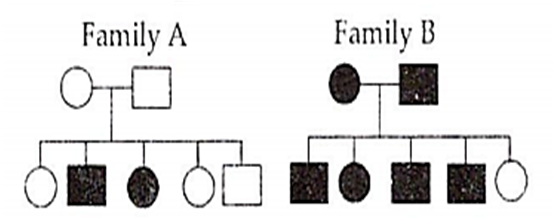 Multiple Choice Questions
Multiple Choice QuestionsWhich of the following is true for a recessive disease in Family A and B?

In family A, both the parents are homozygous recessive
In family B, both the parents are heterozygous dominant.
In family B, both the parents are heterozygous recessive
In family A, both the parents are heterozygous recessive.
Assertion: In a pedigree analysis, <5> represents five unaffected offsprings.
Reason: In a pedigree analysis, the offsprings are numbered with arabic numerals (1, 2, 3 .....) and a generation is numbered with roman numerals (I, II, III...).
If both assertion and reason are true and reason is the correct explanation of assertion.
If both assertion and reason are true but reason is not the correct explanation of assertion.
If assertion is true but reason is false.
If both assertion and reason are false.
Assertion: Hbs Hbs denotes the homozygous condition for sickle-cell anaemia.
Reason: It occurs due to substitution of glutamic acid by valine at the 6 position of (B-chain of Hb.
If both assertion and reason are true and reason is the correct explanation of assertion.
If both assertion and reason are true but reason is not the correct explanation of assertion.
If assertion is true but reason is false.
If both assertion and reason are false.
Assertion : Only a boy child could be born with a substitution of glutamic acid by valine on 6 codon of beta-chain of haemoglobin.
Reason : The gene for the above mutation is found on Y-chromosome.
If both assertion and reason are true and reason is the correct explanation of assertion.
If both assertion and reason are hue but reason is not the correct explanation of assertion.
If assertion is true but reason is false.
If both assertion and reason are false.
Which of the following disorders are caused due to recessive autosomal mutations?
Turner"s syndrome and sickle cell anaemia
Edward's syndrome and Down's syndrome
Cystic fibrosis and phenylketonuria
Alzheimer's disease and Huntington's chorea
Which of the following diseases is also called Christmas disease?
Sickle-cell anaemia
Haemoglobinuria
Myocardial infarction
Haemophilia- B
Assertion : Antirrhinum is a good example to understand incomplete dominance.
Reason : Heterozygotes show characteristics of both the alleles.
If both assertion and reason are true and reason is the correct explanation of assertion
If both assertion and reason are true but reason is not the correct explanation of assertion
If assertion is true but reason is false
If both assertion and reason are false.
Which of the following is correct
Henking discovered the small Y-chromosome.
Drosophila also shows XX-XY sex determination like human.
Birds have ZZ-ZW sex determination, where females are ZZ & males are ZW.
Grasshoppers show XX-XY sex determination
Percentage of recombination between A and B is 9%, A and C is 17%, B and C is 26% , then the arrangement of genes is
ABC
ACB
BCA
BAC
Which of the following conditions represents a case of co-dominant genes?
A gene expresses itself, suppressing the phenotypic effect of its alleles
Genes that are similar in phenotypic effect when present separately, but when together interact to produce a different trait
Alleles, both of which interact to produce a trait, which may or may not resemble either of the parental types
Alleles, each of which produces an independent effect in a heterozygous condition
